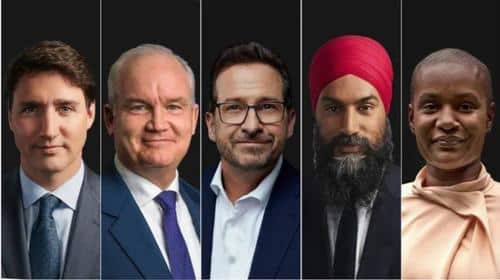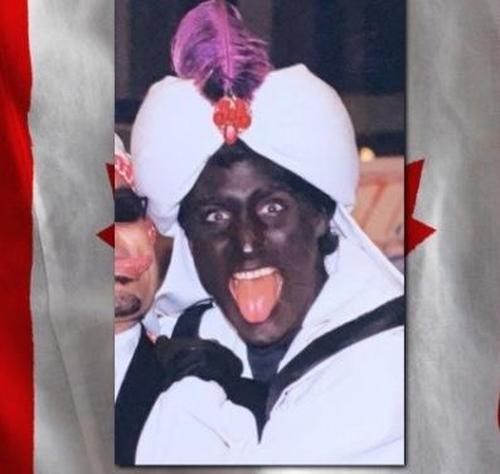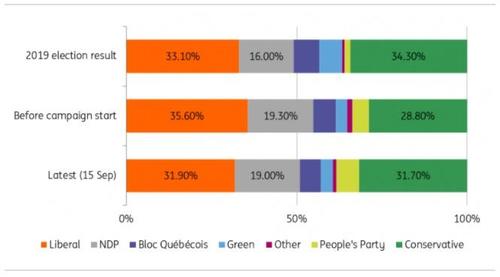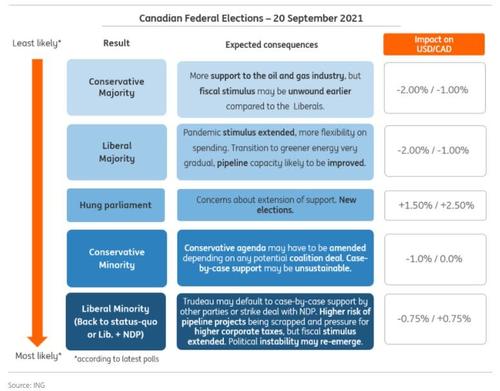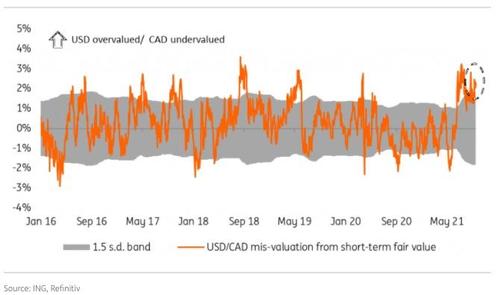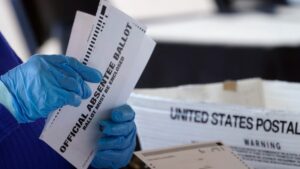With polls suggesting an extremely tight race, Canadians are heading to the polls on Monday to vote in a snap federal election that was called last month by Prime Minister Justin Trudeau to try and achieve an outright parliamentary majority by Trudeau’s Liberals.
Unfortunately for Trudeau, in the weeks since he called the election, the Liberals have seen their lead slide, and are now running virtually neck-and-neck with the Conservatives. Souring support for Trudeau means it’s entirely possible that the political scion could lose the premiership after six years in power, leaving Erin O’Toole and his conservatives to form a new government.
While the New Democratic Party and the Greens attacked Trudeau from the left, the conservatives have slammed Trudeau’s flashy, “entitled” persona while arguing that Trudea’s mishandling of the economy has created “Liberal inflation” squeezing Canadians by raising the cost of living.
Source: Canadian Broadcassting Corporation
Candidates scrambled to attend to packed schedules of last-minute campaigning on Monday, with Trudeau (who launched the “snap” election with a short walk to Rideau Hall on Aug. 15) kicking off the day with an event in Montreal. He’s expected to touch down in several provinces before Tuesday, although he’s not expected to speak with reporters – and, unsurprisingly, there’s a good reason for that.
On Monday, with voters heading to the polls, Trudeau’s enemies released a new (and this time, in color) photo of the PM wearing blackface at an event back in 2001. While previous photos have emerged from the event showing Trudeau wearing a ridiculous Middle-Eastern getup complete with the dark face makeup, the earlier photos were (ironically) black and white. As we have reported, Trudeau has appeared in public wearing blackface at least three times during his younger years, long before the start of his political career (which comes courtesy of the fact that he’s the son of a former premier, although some have contested the ‘official’ story about his parentage, speculating that he might be the son of a different former world leader).
Shifting back to the beginnings of the campaign, Trudeau claimed Canadians deserved a say in how Canada would recover from the COVID pandemic in a transparent excuse to try to capitalize on strong polling numbers. O’Toole has accused Trudeau of putting Canadians’ health at risk in pursuit of his own political ends. The premier has spent his 6 years in power without a unilateral majority, making it more difficult to implement his agenda.
As Trudeau’s initial lead evaporated, the Liberals’ message morphed, changing into a mix of asking voters whom they trust to end the pandemic, along with a series of attacks against the Conservatives on climate, guns and vaccine policy. Trudeau said Sunday that Canada is at a “crossroads”.
Perhaps unsurprisingly, Trudeau has dedicated most of his time to campaigning in recent weeks. More than any other leader, the PM has spent the campaign on the defensive, visiting more ridings currently held by Liberals than those controlled by opposition parties, according to an analysis of the leaders’ schedules by the CBC.
O’Toole has gained ground in the polls partly by pursuing a moderate policy stance with a platform that focuses on issues like jobs and the economy, mental health and includes pitches to workers.
“I want you to know if you’re frustrated, if you’re angry anywhere in this country, I want you to know something. I get it. Conservatives get it,” O’Toole said at a Saturday rally in Kitchener, Ont.
“Now is the time for Canadians to make a choice,” O’Toole said Sunday in Markham, Ont. “We can choose to settle for second-best — for a party that hardly tries and barely delivers. Or we can choose to believe in a brighter, better, more united future.”
Until just a few days ago, the Conservatives had held a substantial lead over Trudeau’s Liberals in the polls, before a decline brought them to a statistical tie in national support with the Liberals, according to CBC’s Poll Tracker. A snapshot of polling numbers from ING shows how public sentiment has shifted over time, with opposition parties eating away at the Liberals’ lead.
The Liberals currently hold 155 of the 388 seats in the House of Commons. Polls suggest the risks are skewed towards them losing a few of those seats rather than being able to add. They would need to pick up 15 seats in order to reach the 170 seat threshold that would allow them to govern without the support of another party. If anything, polls suggest that a minority Conservative win is more likely than a majority win by the Liberals, as shown in the polls-implied probabilities in the chart below.
In a note to clients, ING explains that the election has implications for markets, with the two main ones being the impact on fiscal stimulus plans, along with energy/pipeline policy.
Here’s a breakdown of the most important issues for markets courtesy of ING strategists and economists led Francesco Pesole and James Knightley:
1. Fiscal spending: markets should welcome a continuation of Trudeau’s support
Trudeau’s massive fiscal support programme was a pillar of his government’s pandemic-response strategy, with total support nearing 20% of GDP.
Pandemic-induced stimulus is gradually being unwound, but based on the latest campaign pledges, the general feeling is that the Liberals will be more relaxed with further deficit expansions, while the Conservatives have pledged to balance the budget over the long term. Consequently, there is the expectation that they will scale back stimulus quicker than the Liberals, which would likely see slower growth, less inflation and lead to a lessened probability of a major Bank of Canada policy tightening outlook.
The complicating factor is if there isn’t a majority for either party and they need the support of the New Democrat Party (NDP) which is advocating higher corporate, capital gains and income taxes for top earners. If they end up supporting the liberals it may not have as much as an influence on policy thrust as if they partner with the Conservatives.
One caveat concerns Trudeau’s promise to hike tax rates (from 15% to 18%) on all earnings over CA$ 1bn for banks and insurers. Such a measure may send some shockwaves across banking stocks in Canada, but for the moment we think that the prospect of extended fiscal stimulus should be the primary driver of the market response and benefit the Canadian dollar through expectations that fiscal support will allow the Bank of Canada to remain on its policy-normalisation path.
2. Energy sector: Trudeau is pro-pipeline, but his potential coalition partners are not
The energy sector contributes to approximately 10% of Canada’s GDP every year, but aside from the headwinds generated by the pandemic in the past year, the industry has been looking at some longstanding structural issues that may dent its ability to take advantage of higher oil prices.
A major issue remains the lack of pipeline capacity, as many Canadian oil and gas producers remain heavily dependent on the more expensive rail system as a means of transportation. Trudeau has been historically in favour of expanding Canada’s pipeline network, but new projects have found increasing opposition from environmentalist parties (like the Greens and the NDP). Also, this year, US President Joe Biden’s opposition caused the cross-border Keystone XL expansion project to be scrapped.
Despite the Liberals’ official stance for increasing pipeline capacity, the parties that are most likely to join a coalition (like the NDP) are explicitly against it. This means that the more Trudeau will have to rely on coalition deals with left-wing parties to govern, the less likely the pipeline situation is going to be resolved.
The Conservatives are openly in favour of new pipeline projects and retain in general the friendliest stance to the traditional oil-and-gas industry among all parties. Their plans for a transition away from carbon fossil fuels looks likely to be more gradual than that proposed by the other parties, and they plan to actually provide more subsidies to the struggling industry.
Bottom line: A workable majority is what matters the most for CAD
The Canadian dollar has likely discounted some degree of political uncertainty lately as polls showed the Liberal party’s hopes for an outright majority becoming more and more distant. Some evidence of this is the risk premium currently embedded into USD/CAD. According to our short-term fair value model (which includes rate differentials, relative equity performance, risk sentiment and commodity factors as variables) USD/CAD is currently 2% overvalued, a level that is above the 1.5 standard-deviation upper bound – as shown in the chart below.
When discussing the two main policy themes that we think markets are mostly keeping an eye on in this Canadian election campaign, we suggest that a minority win by the Liberals could see CAD benefit from better fiscal stimulus prospects, and a minority win by the Conservatives may mean CAD being supported through a better outlook for the oil and gas industry in Canada.
Ultimately, however, we think the market reaction will depend much more on whether the vote will allow room for a workable majority to emerge and guarantee political stability in the coming years, rather than which party will come up as the winner.
The best-case scenario for CAD is undoubtedly a majority win by either one of the two parties, but that seems to be a low-probability outcome if the latest polls are to be trusted. The most likely scenario of either the Liberals or the Conservatives winning most seats but having to rely on other parties (either on a case-by-case basis like the latest government, or through coalition deals) to govern may ultimately have a quite contained impact on CAD.
However, a minority win would pave the way for a potential hung parliament. We should know more on Tuesday, as post-election comments start to outline the different possible political scenarios, but from an FX point of view, we think that any political-noise risk premium embedded in CAD may remain in place until a clear working majority materialises.
* * *
As far as the other candidates are concerned, Bloc Québécois Leader Yves-François Blanchet is hoping to pick up seats for his party to help protect Quebec’s independence. NDP Leader Jagmeet Singh hasn’t held back when it comes to criticizing Trudeau from the left. Green Party Leader Annamie Paul is finishing her campaign in Toronto Centrer, her own riding (for the Americans who aren’t familiar, a riding is like a Congressional district), which she has rarely left over the past five weeks. Weakened by internal conflict, the Greens may struggle to defend their two seats in Parliament.
Finally, Lee Friday from the Mises Institute mused in a recent piece that all three candidates are guilty of various transgressions and broken promises and none are particularly exciting, about the vote that Canadians might be better off voting “none of the above”. Given the close polling, it’s likely a clear winner won’t be known until Tuesday, or perhaps later in the week.
In the Atlantic provinces, polls open at 0830 and close at 2030 local time. In the Eastern time zone, which encompasses nearly all of Quebec and Ontario as well as part of Nunavut, polls will be open between 0930 and 2130. Those voting in the election for Canada’s 44th Parliament must bring proper identification to vote.
As far as elections go, the Canadian is the first of two major elections among the G-7 during the latter half of September. On Sept. 26, Germans will take to the polls to elect a successor to Chancellor Angela Merkel. It’s a vote where “the unthinkable has become possible”. Read more here to find out why.

